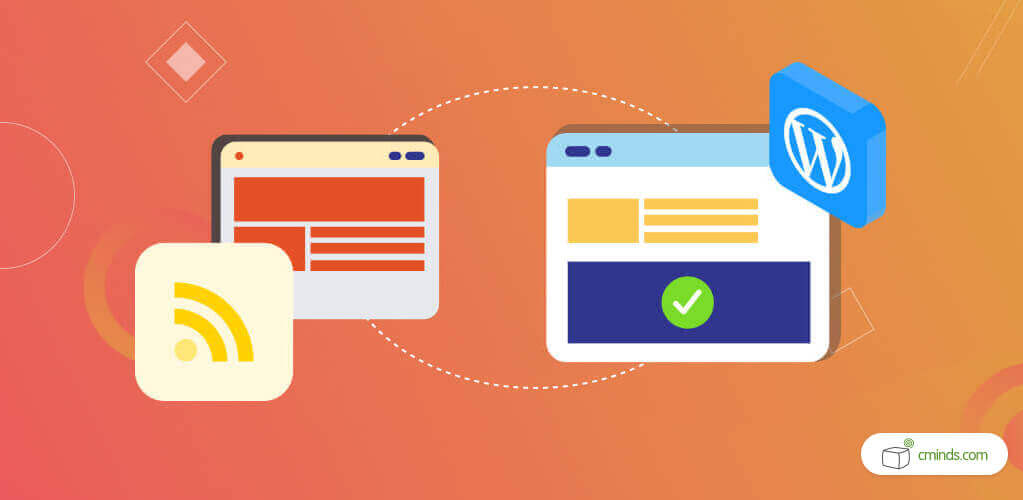What is RSS? If you’re curious, here’s everything you need to know about the classic web technology.

We call it a “classic” with love, of course. RSS is a fairly old web technology, but it’s far from obsolete.
In this blog we’re taking a closer look at RSS, helping you to better understand what is RSS, how RSS feeds work, and how using RSS can increase your website traffic.
April 2024 Offer – For a Limited Time Only:
Get Curated RSS Aggregator Plugin for 20% off! Don’t miss out!
What is RSS?

RSS stands for Really Simply Syndication or Rich Site Summary. It’s a web feed that allows users and applications to access updates to websites in a standardized, computer-readable format.
Each time a website publishes a new piece of content, details about that content – like the full-text of the content or a summary, publication date, author, and link – are available.
RSS makes it easy for users to subscribe to your content. Using an RSS feed, they can receive updates from your blog or website directly in their feed readers, desktop applications, and other devices.
With RSS, your subscribers don’t need to remember your website URL because they can bring the content into a central location where they like to read all of their favorite online at once.
Using an RSS Reader

RSS feeds are typically coded in XML format. This XML document can then be fetched and read with a RSS feed reader. There are many RSS feed reader software available for all operating systems, desktops, and mobile devices.
With WordPress, there is a built-in support for RSS feeds. By default, each page of your WordPress site contains a meta tag that points to your website’s RSS feed location.
There is also a default RSS widget in WordPress that you can add to your sidebar and display latest posts from any other blog. You can use this widget to cross-promote your own blogs.
The first thing you’ll want to do if you’re getting into reading sites via RSS is to hook yourself up with an RSS Feed Reader. There are many feed readers around with a variety of features.
Feedly, for example, is very user-friendly and easy to install and use. It’s great for getting to know the basics of RSS.
Feed readers work a little like email. As you subscribe to feeds you’ll see that unread entries from the sites you’re tracking will be marked in bold. As you click on them you’ll see the latest updates and can read it right there in the feed reader. You are given the option to click through to the actual site or move onto the next unread item – marking the last one as ‘read’.
Why Use RSS?
There are many benefits of using RSS. These include:
- Make Your Content Portable. RSS feed content can be read offline. That means your subscribers can take your content with them on the go.
- Build a Following. RSS feeds help you build and nurture a loyal following around your blog. RSS subscribers are much more likely to share your content on social media.
- Organize Your Content. Most modern feed readers allow you to sort your reading lists into categories and groups. By using RSS efficiently, you can really maximize reading time.
How RSS Adds Content to Your Website

RSS can help websites solve problems. A lot of internet users are interested in many different websites. Updates are posted to different sites at different times, often on an unpredictable schedule.
Examples of such websites are news sites; community and religious organization information pages; product information pages; medical websites; and weblogs. Repeatedly checking each website to see if there is any new content can be tedious and time consuming. RSS feeds cut out the time it takes to trawl your favorite websites.
First of all, if you are not already building an email list, then you need to start! RSS feeds can help you with this. You can easily turn your website visitors into loyal RSS subscribers by using lead generation software.
Social media platforms like Facebook, Twitter, and LinkedIn can help you grow your website traffic. However, to keep your social media profiles active you need to regularly post relevant content.
It is actually becoming increasingly common for websites to have RSS feeds. They usually indicate the feed on the home page or main news page with a link to “RSS”, or sometimes by displaying an orange button with the letters “XML” or “RSS”.
RSS feeds are also often found via a “Syndicate This” link.
Text “RSS” links sometimes point to a web page explaining the nature of the RSS feeds provided and how to find them. The buttons are often linked directly to the RSS feed file itself.
RSS feeds also work due to aggregators. An aggregator is responsible for the convenience of RSS feeds. The RSS aggregator checks websites for new content automatically.
This immediately pulls that content over to your feed reader so you don’t have to go and check each website individually to find new content.
The aggregator even keeps track of what you have and have not read by listing the number of articles or pieces of content for each website you are following that has not been seen. This helps you quickly scan content from the websites that interest you.
Conclusion
We hope we’ve answered your question “What is RSS?”
RSS feeds are wonderful for accessing everything a website has to offer. This also means that websites shouldn’t hesitate to make their own content available for RSS readers.
RSS feeds are an excellent way to keep all of your content in one place, without having to go searching for it. Also, these feeds are user-friendly and easy to add to your website, and expand your content marketing.
Customizable to your tastes, an RSS feed ensures you don’t miss information on topics that you’re interested in. Overall, RSS is a great tool for expanding content marketing by providing curated, up-to-date content.



